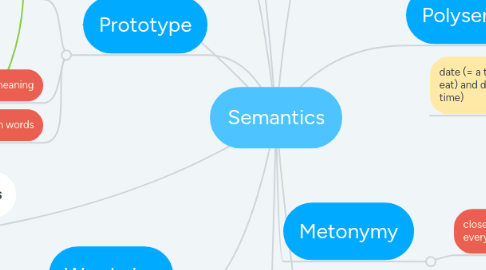Semantics
by litzy Gamez


1. At its core, is the study of the changing associations between concrete, changeable forms and abstract, unchanging concepts.
2. sparrow is a prototype of the word bird
3. of component features
4. Prototype
4.1. helps explain
4.2. the meaning
4.3. of certain words
5. but in terms of resemblance
6. not in terms
7. Word play
8. to the clearest example
9. clever and witty use
10. of words and meaning
11. FORMAL SEMANTICS
11.1. Is about the meaning of syntactically complex expressions. >Literally means "using formal methods for the study of meaning." [Nowadays there is also formal lexical semantics and discourse semantics, but the identification "formal semantics - formal sentence semantics.
12. DIACHRONIC SEMANTICS:
13. 1. PRINCIPLE OF COMPOSITIONALITY-the meaning of an expression is uniquely determined by the meanings of its parts and their mode of combination.
14. SEMANTIC CHANGE Also known as SEMANTIC SHIFT or SEMANTIC PROGRESSION describes the evolution of word usage -usually to the point that the modern meaning is radically different from the original usage.
15. Two or more different
16. (written) forms
17. have the same pronunciation,
17.1. homophones.
18. Homophones and homonyms
18.1. one form (written or spoken)
19. more unrelated meanings,
19.1. homonyms
20. has two or
21. Polysemy
21.1. two or more words
21.1.1. with the same form
22. date (= a thing we can eat) and date (=a point in time)
23. form and related meanings,
24. Metonymy
24.1. close connection in everyday experience.
24.1.1. container–contents relation (bottle/water, can/juice)
24.1.2. whole–part relation (car/wheels, house/roof)
24.1.3. representative–symbol relationship (king/crown, the President/the White House)
